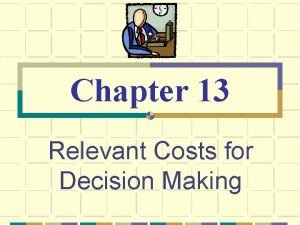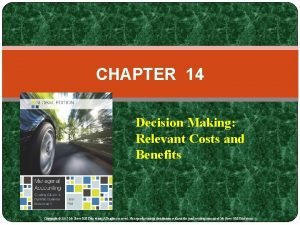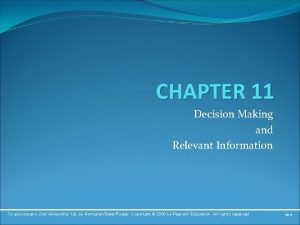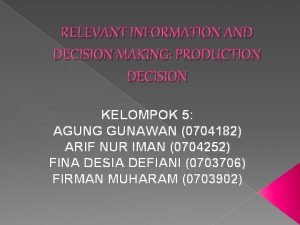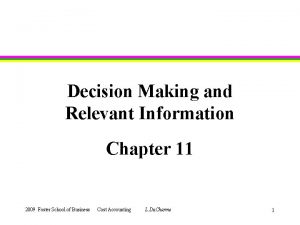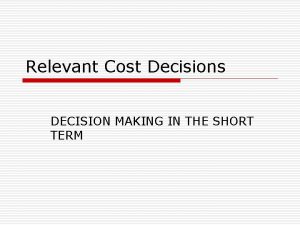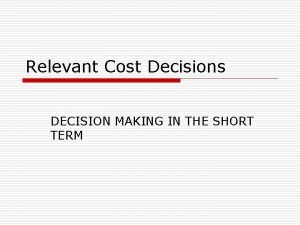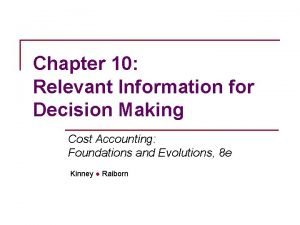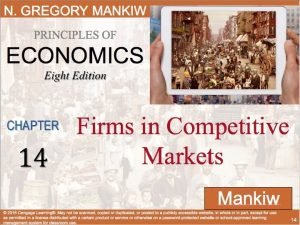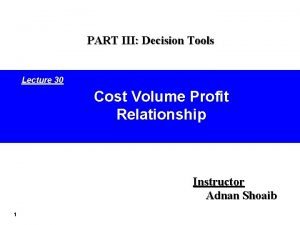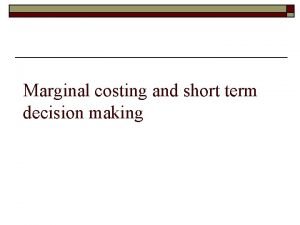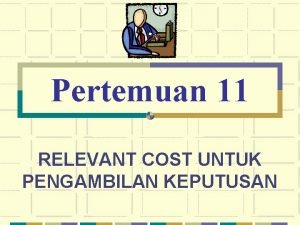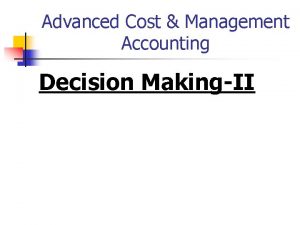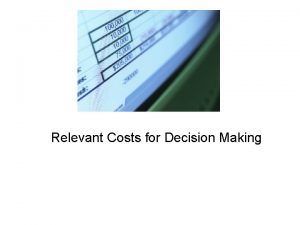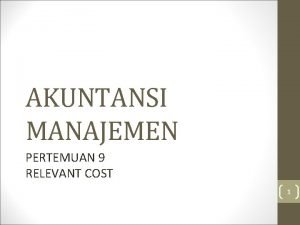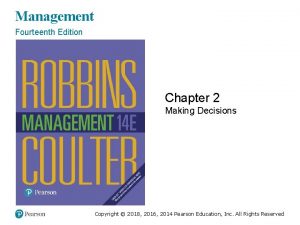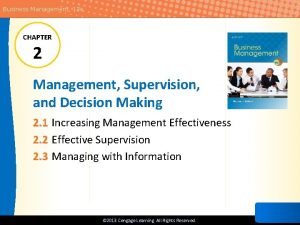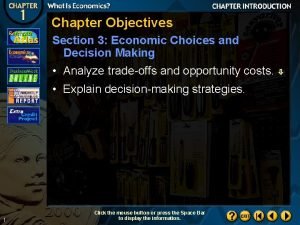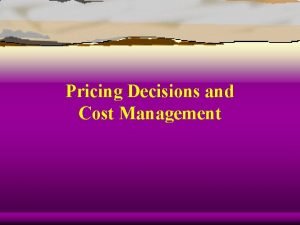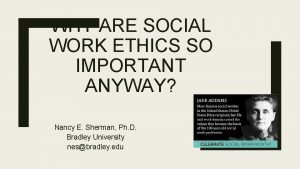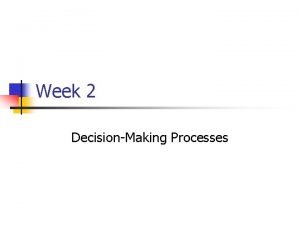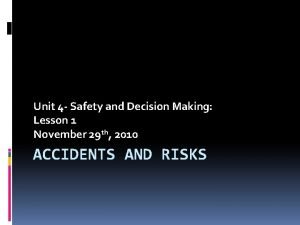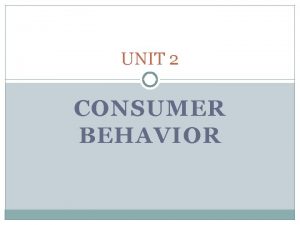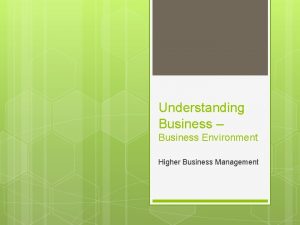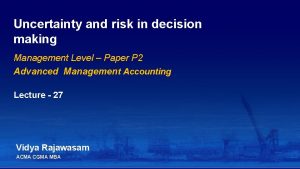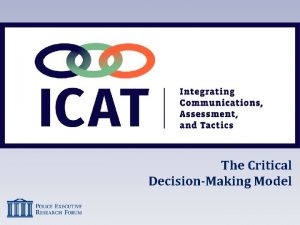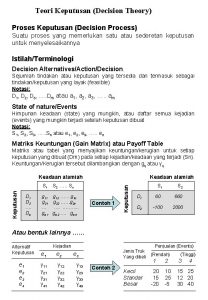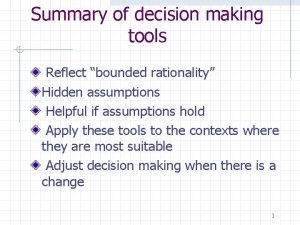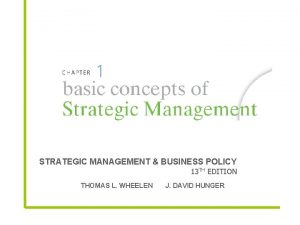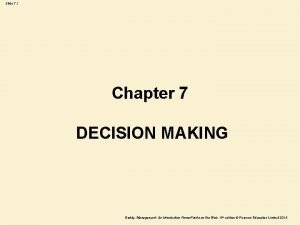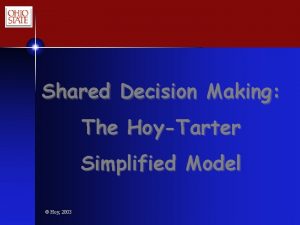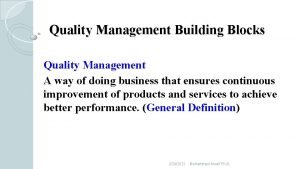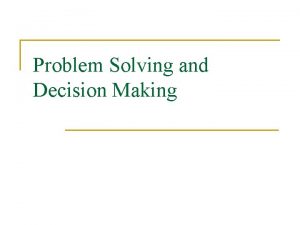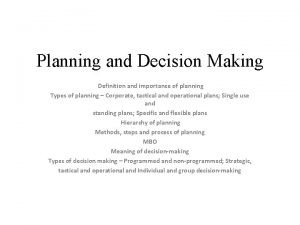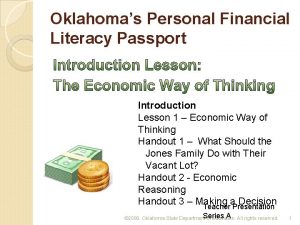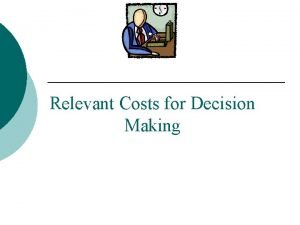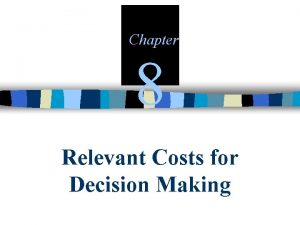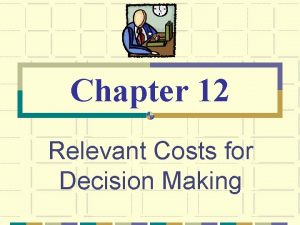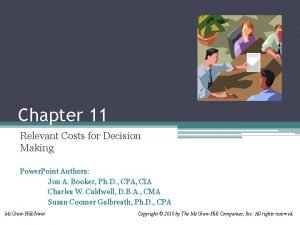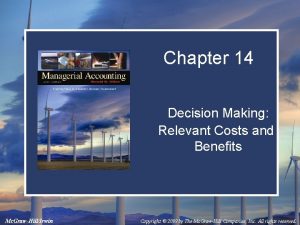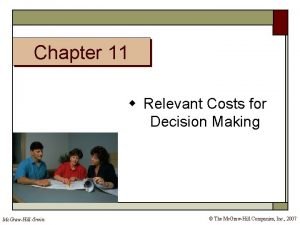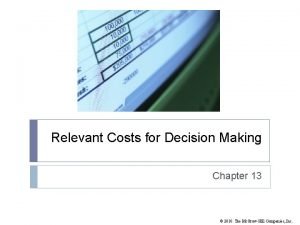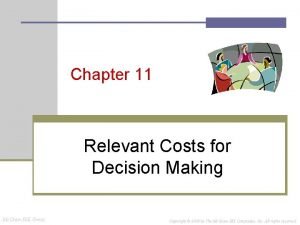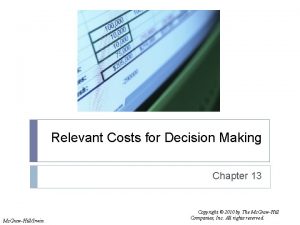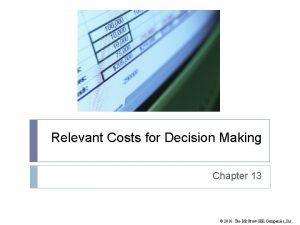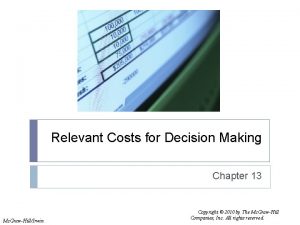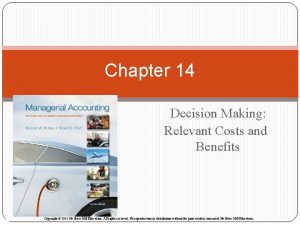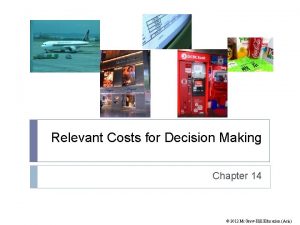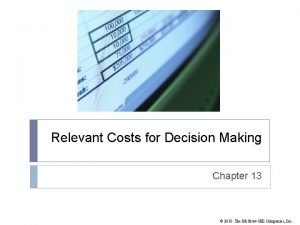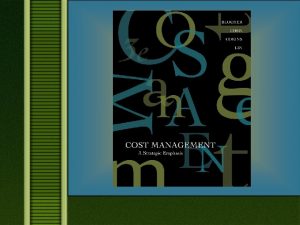Chapter 13 Relevant Costs for Decision Making Cost




































































- Slides: 68

Chapter 13 Relevant Costs for Decision Making

Cost Concepts for Decision Making A relevant cost is a cost that differs between alternatives. 1 Mc. Graw-Hill/Irwin 2 © The Mc. Graw-Hill Companies, Inc. , 2003

Identifying Relevant Costs that can be eliminated (in whole or in part) by choosing one alternative over another are avoidable costs. Avoidable costs are relevant costs. Unavoidable costs are never relevant and include: Sunk costs. Future costs that do not differ between the alternatives. Mc. Graw-Hill/Irwin © The Mc. Graw-Hill Companies, Inc. , 2003

Identifying Relevant Costs Cynthia, a Boston student, is considering visiting her friend in New York. She can drive or take the train. By car it is 230 miles to her friend’s apartment. She is trying to decide which alternative is less expensive and has gathered the following information: $45 per month × 8 months $1. 60 per gallon ÷ 32 MPG $18, 000 cost – $4, 000 salvage value ÷ 5 years Mc. Graw-Hill/Irwin © The Mc. Graw-Hill Companies, Inc. , 2003

Identifying Relevant Costs Mc. Graw-Hill/Irwin © The Mc. Graw-Hill Companies, Inc. , 2003

Identifying Relevant Costs Which costs and benefits are relevant in Cynthia’s decision? The cost of the car is a sunk cost and is not relevant to the current decision. The annual cost of insurance is not relevant. It will remain the same if she drives or takes the train. However, the cost of gasoline is clearly relevant if she decides to drive. If she takes the drive the cost would now be incurred, so it varies depending on the decision. Mc. Graw-Hill/Irwin © The Mc. Graw-Hill Companies, Inc. , 2003

Identifying Relevant Costs Which costs and benefits are relevant in Cynthia’s decision? The cost of maintenance and repairs is relevant. In the long-run these costs depend upon miles driven. The monthly school parking fee is not relevant because it must be paid if Cynthia drives or takes the train. At this point, we can see that some of the average cost of $0. 569 per mile are relevant and others are not. Mc. Graw-Hill/Irwin © The Mc. Graw-Hill Companies, Inc. , 2003

Identifying Relevant Costs Which costs and benefits are relevant in Cynthia’s decision? The decline in resale value due to additional miles is a relevant cost. The round-trip train fare is clearly relevant. If she drives the cost can be avoided. Relaxing on the train is relevant even though it is difficult to assign a dollar value to the benefit. The kennel cost is not relevant because Cynthia will incur the cost if she drives or takes the train. Mc. Graw-Hill/Irwin © The Mc. Graw-Hill Companies, Inc. , 2003

Identifying Relevant Costs Which costs and benefits are relevant in Cynthia’s decision? The cost of parking is relevant because it can be avoided if she takes the train. The benefits of having a car in New York and the problems of finding a parking space are both relevant but are difficult to assign a dollar amount. Mc. Graw-Hill/Irwin © The Mc. Graw-Hill Companies, Inc. , 2003

Identifying Relevant Costs From a financial standpoint, Cynthia would be better off taking the train to visit her friend. Some of the non-financial factor may influence her final decision. Mc. Graw-Hill/Irwin © The Mc. Graw-Hill Companies, Inc. , 2003

Note Do not underestimate the importance and power of the relevant cost idea. Most costs (and benefits) do not differ between alternatives. This allows you to focus on the few things that matter. This principle also helps avoid mistakes. Mc. Graw-Hill/Irwin © The Mc. Graw-Hill Companies, Inc. , 2003

Total and Differential Cost Approaches The management of a company is considering a new laborsaving machine that rents for $3, 000 per year. Data about the company’s annual sales and costs with and without the new machine are: Mc. Graw-Hill/Irwin © The Mc. Graw-Hill Companies, Inc. , 2003

Total and Differential Cost Approaches As you see, the only costs that differ between the alternatives are the direct labor costs savings and the increase in fixed rental costs. We can efficiently analyze the decision by looking at the different costs and revenues and arrive at the same solution. Mc. Graw-Hill/Irwin © The Mc. Graw-Hill Companies, Inc. , 2003

Adding/Dropping Segments One of the most important decisions managers make is whether to add or drop a business segment such as a product or a store. Let’s see how relevant costs should be used in this decision. Mc. Graw-Hill/Irwin © The Mc. Graw-Hill Companies, Inc. , 2003

Adding/Dropping Segments Due to the declining popularity of digital watches, Lovell Company’s digital watch line has not reported a profit for several years. An income statement for last year is shown on the next screen. Mc. Graw-Hill/Irwin © The Mc. Graw-Hill Companies, Inc. , 2003

Adding/Dropping Segments Mc. Graw-Hill/Irwin © The Mc. Graw-Hill Companies, Inc. , 2003

Adding/Dropping Segments Investigation has revealed that total fixed general factory overhead and general administrative expenses would not be affected if the digital watch line is dropped. The fixed general factory overhead and general administrative expenses assigned to this product would be reallocated to other product lines. Mc. Graw-Hill/Irwin © The Mc. Graw-Hill Companies, Inc. , 2003

Adding/Dropping Segments The equipment used to manufacture digital watches has no resale value or alternative use. Should Lovell retain or drop the digital watch segment? Mc. Graw-Hill/Irwin © The Mc. Graw-Hill Companies, Inc. , 2003

A Contribution Margin Approach DECISION RULE Lovell should drop the digital watch segment only if its profit would increase. This would only happen if the fixed cost savings exceed the lost contribution margin. Let’s look at this solution. Mc. Graw-Hill/Irwin © The Mc. Graw-Hill Companies, Inc. , 2003

A Contribution Margin Approach Mc. Graw-Hill/Irwin © The Mc. Graw-Hill Companies, Inc. , 2003

Comparative Income Approach The Lovell solution can also be obtained by preparing comparative income statements showing results with and without the digital watch segment. Let’s look at this second approach. Mc. Graw-Hill/Irwin © The Mc. Graw-Hill Companies, Inc. , 2003

If the digital watch line is dropped, the company gives up its contribution margin. Mc. Graw-Hill/Irwin © The Mc. Graw-Hill Companies, Inc. , 2003

On the other hand, the general factory overhead would be the same. So this cost really isn’t relevant. Mc. Graw-Hill/Irwin © The Mc. Graw-Hill Companies, Inc. , 2003

But we wouldn’t need a manager for the product line anymore. Mc. Graw-Hill/Irwin © The Mc. Graw-Hill Companies, Inc. , 2003

If the digital watch line is dropped, the net book value of the equipment would be written off. The depreciation that would have been taken will flow through the income statement as a loss instead. Mc. Graw-Hill/Irwin © The Mc. Graw-Hill Companies, Inc. , 2003

Mc. Graw-Hill/Irwin © The Mc. Graw-Hill Companies, Inc. , 2003

Beware of Allocated Fixed Costs Why should we keep the digital watch segment when it’s showing a loss? Mc. Graw-Hill/Irwin © The Mc. Graw-Hill Companies, Inc. , 2003

Beware of Allocated Fixed Costs The answer lies in the way we allocate common fixed costs to our products. Mc. Graw-Hill/Irwin © The Mc. Graw-Hill Companies, Inc. , 2003

Beware of Allocated Fixed Costs Our allocations can make a segment look less profitable than it really is. Mc. Graw-Hill/Irwin © The Mc. Graw-Hill Companies, Inc. , 2003

The Make or Buy Decision A decision concerning whether an item should be produced internally or purchased from an outside supplier is called a “make or buy” decision. Let’s look at the Essex Company example. Mc. Graw-Hill/Irwin © The Mc. Graw-Hill Companies, Inc. , 2003

The Make or Buy Decision Essex manufactures part 4 A that is used in one of its products. The unit product cost of this part is: Mc. Graw-Hill/Irwin © The Mc. Graw-Hill Companies, Inc. , 2003

The Make or Buy Decision The special equipment used to manufacture part 4 A has no resale value. The total amount of general factory overhead, which is allocated on the basis of direct labor hours, would be unaffected by this decision. The $30 unit product cost is based on 20, 000 parts produced each year. An outside supplier has offered to provide the 20, 000 parts at a cost of $25 per part. Should we accept the supplier’s offer? Mc. Graw-Hill/Irwin © The Mc. Graw-Hill Companies, Inc. , 2003

The Make or Buy Decision 20, 000 × $9 per unit = $180, 000 Mc. Graw-Hill/Irwin © The Mc. Graw-Hill Companies, Inc. , 2003

The Make or Buy Decision The special equipment has no resale value and is a sunk cost. Mc. Graw-Hill/Irwin © The Mc. Graw-Hill Companies, Inc. , 2003

The Make or Buy Decision Not avoidable; irrelevant. If the product is dropped, it will be reallocated to other products. Mc. Graw-Hill/Irwin © The Mc. Graw-Hill Companies, Inc. , 2003

The Make or Buy Decision Should we make or buy part 4 A? Mc. Graw-Hill/Irwin © The Mc. Graw-Hill Companies, Inc. , 2003

The Make or Buy Decision DECISION RULE In deciding whether to accept the outside supplier’s offer, Essex isolated the relevant costs of making the part by eliminating: eliminating The sunk costs. l The future costs that will not differ between making or buying the parts. l Mc. Graw-Hill/Irwin © The Mc. Graw-Hill Companies, Inc. , 2003

Opportunity Cost The benefits that are foregone as a result of pursuing some course of action. Opportunity costs are not actual dollar outlays and are not recorded in the formal accounts of an organization. Mc. Graw-Hill/Irwin © The Mc. Graw-Hill Companies, Inc. , 2003

Quick Check Which of the following are opportunity costs of attending the university? a. Tuition. b. Books. c. Lost wages. d. Not enough time for other interests. Mc. Graw-Hill/Irwin © The Mc. Graw-Hill Companies, Inc. , 2003

Quick Check Which of the following are opportunity costs of attending the university? a. Tuition. b. Books. c. Lost wages. d. Not enough time for other interests. Opportunity costs do not have to involve money. Mc. Graw-Hill/Irwin © The Mc. Graw-Hill Companies, Inc. , 2003

Special Orders Jet, Inc. makes a single product whose normal selling price is $20 per unit. ¤ A foreign distributor offers to purchase 3, 000 units for $10 per unit. ¤ This is a one-time order that would not affect the company’s regular business. ¤ Annual capacity is 10, 000 units, but Jet, Inc. is currently producing and selling only 5, 000 units. ¤ Should Jet accept the offer? Mc. Graw-Hill/Irwin © The Mc. Graw-Hill Companies, Inc. , 2003

Special Orders $8 variable cost Mc. Graw-Hill/Irwin © The Mc. Graw-Hill Companies, Inc. , 2003

Special Orders If Jet accepts the offer, net operating income will increase by $6, 000. Note: This answer assumes that fixed costs are unaffected by the order and that variable marketing costs must be incurred on the special order. Mc. Graw-Hill/Irwin © The Mc. Graw-Hill Companies, Inc. , 2003

Utilization of a Constrained Resource Firms often face the problem of deciding how to best utilize a constrained resource. Usually fixed costs are not affected by this particular decision, so management can focus on maximizing total contribution margin. Let’s look at the Ensign Company example. Mc. Graw-Hill/Irwin © The Mc. Graw-Hill Companies, Inc. , 2003

Utilization of a Constrained Resource Ensign Company produces two products and selected data is shown below: Mc. Graw-Hill/Irwin © The Mc. Graw-Hill Companies, Inc. , 2003

Utilization of a Constrained Resource Machine A 1 is the constrained resource and is being used at 100% of its capacity. There is excess capacity on all other machines. Machine A 1 has a capacity of 2, 400 minutes per week. Should Ensign focus its efforts on Product 1 or 2? Mc. Graw-Hill/Irwin © The Mc. Graw-Hill Companies, Inc. , 2003

Quick Check How many units of each product can be processed through Machine A 1 in one minute? a. b. c. d. Mc. Graw-Hill/Irwin Product 1 1 unit 2 units Product 2 0. 5 unit 2. 0 units 1. 0 unit 0. 5 unit © The Mc. Graw-Hill Companies, Inc. , 2003

Quick Check How many units of each product can be processed through Machine A 1 in one minute? a. b. c. d. Product 1 1 unit 2 units Product 2 0. 5 unit 2. 0 units 1. 0 unit 0. 5 unit I was just checking to make sure you are with us. Mc. Graw-Hill/Irwin © The Mc. Graw-Hill Companies, Inc. , 2003

Quick Check What generates more profit for the company, using one minute of machine A 1 to process Product 1 or using one minute of machine A 1 to process Product 2? a. Product 1 b. Product 2 c. They both would generate the same profit d. Cannot be determined Mc. Graw-Hill/Irwin © The Mc. Graw-Hill Companies, Inc. , 2003

Quick Check With one minute of machine A 1, we could make 1 unit of What Product 1, with a contribution $24, or 2 generates more profit margin for the of company, units of Product 2, each a contribution margin of using one minute of with machine A 1 to process $15. 2 × $15 $24 one minute of machine A 1 to Product 1 or> using process Product 2? a. Product 1 b. Product 2 c. They both would generate the same profit d. Cannot be determined Mc. Graw-Hill/Irwin © The Mc. Graw-Hill Companies, Inc. , 2003

Utilization of a Constrained Resource The key is the contribution margin per unit of the constrained resource. Product 2 should be emphasized. Provides more valuable use of the constrained resource machine A 1, yielding a contribution margin of $30 per minute as opposed to $24 for Product 1. Mc. Graw-Hill/Irwin © The Mc. Graw-Hill Companies, Inc. , 2003

Utilization of a Constrained Resource The key is the contribution margin per unit of the constrained resource. If there are no other considerations, the best plan would be to produce to meet current demand for Product 2 and then use remaining capacity to make Product 1. Mc. Graw-Hill/Irwin © The Mc. Graw-Hill Companies, Inc. , 2003

Utilization of a Constrained Resource Let’s see how this plan would work. Mc. Graw-Hill/Irwin © The Mc. Graw-Hill Companies, Inc. , 2003

Utilization of a Constrained Resource Let’s see how this plan would work. Mc. Graw-Hill/Irwin © The Mc. Graw-Hill Companies, Inc. , 2003

Utilization of a Constrained Resource Let’s see how this plan would work. Mc. Graw-Hill/Irwin © The Mc. Graw-Hill Companies, Inc. , 2003

Utilization of a Constrained Resource According to the plan, we will produce 2, 200 units of Product 2 and 1, 300 of Product 1. Our contribution margin looks like this. The total contribution margin for Ensign is $64, 200. Mc. Graw-Hill/Irwin © The Mc. Graw-Hill Companies, Inc. , 2003

Managing Constraints Produce only what can be sold. Finding ways to process more units through a resource bottleneck At the bottleneck itself: • Improve the process • Add overtime or another shift • Hire new workers or acquire more machines • Subcontract production Eliminate waste. Streamline production process. Mc. Graw-Hill/Irwin © The Mc. Graw-Hill Companies, Inc. , 2003

Joint Costs In some industries, a number of end products are produced from a single raw material input. Two or more products produced from a common input are called joint products The point in the manufacturing process where each joint product can be recognized as a separate product is called the split-off point Mc. Graw-Hill/Irwin © The Mc. Graw-Hill Companies, Inc. , 2003

Joint Products Joint Costs Joint Input Common Production Process Oil Gasoline Chemicals Split-Off Point Mc. Graw-Hill/Irwin © The Mc. Graw-Hill Companies, Inc. , 2003

Joint Products Joint Costs Joint Input Common Production Process Oil Gasoline Chemicals Split-Off Point Mc. Graw-Hill/Irwin Separate Processing Final Sale Separate Product Costs © The Mc. Graw-Hill Companies, Inc. , 2003

The Pitfalls of Allocation Joint costs are really common costs incurred to simultaneously produce a variety of end products. Joint costs are often allocated to end products on the basis of the relative sales value of each product or on some other basis. Mc. Graw-Hill/Irwin © The Mc. Graw-Hill Companies, Inc. , 2003

Sell or Process Further It will always profitable to continue processing a joint product after the splitoff point so long as the incremental revenue exceeds the incremental processing costs incurred after the splitoff point. Let’s look at the Sawmill, Inc. example. Mc. Graw-Hill/Irwin © The Mc. Graw-Hill Companies, Inc. , 2003

Sell or Process Further Sawmill, Inc. cuts logs from which unfinished lumber and sawdust are the immediate joint products. Unfinished lumber is sold “as is” or processed further into finished lumber. Sawdust can also be sold “as is” to gardening wholesalers or processed further into “presto-logs. ” Mc. Graw-Hill/Irwin © The Mc. Graw-Hill Companies, Inc. , 2003

Sell or Process Further Data about Sawmill’s joint products includes: Mc. Graw-Hill/Irwin © The Mc. Graw-Hill Companies, Inc. , 2003

Sell or Process Further Mc. Graw-Hill/Irwin © The Mc. Graw-Hill Companies, Inc. , 2003

Sell or Process Further Mc. Graw-Hill/Irwin © The Mc. Graw-Hill Companies, Inc. , 2003

Sell or Process Further Should we process the lumber further and sell the sawdust “as is? ” Mc. Graw-Hill/Irwin © The Mc. Graw-Hill Companies, Inc. , 2003

End of Chapter 13 Mc. Graw-Hill/Irwin © The Mc. Graw-Hill Companies, Inc. , 2003
 Relevant cost for decision making solution chapter 13
Relevant cost for decision making solution chapter 13 Relevant cost for decision making exercises
Relevant cost for decision making exercises Steps in decision making
Steps in decision making Chapter 11 decision making and relevant information
Chapter 11 decision making and relevant information Relevant information for decision making
Relevant information for decision making Decision making and relevant information
Decision making and relevant information Decision making and relevant information
Decision making and relevant information 5 step decision making process
5 step decision making process Decision making and relevant information
Decision making and relevant information Relevant information for decision making
Relevant information for decision making Sunk costs are irrelevant for decision making
Sunk costs are irrelevant for decision making Within the relevant range, variable costs are expected to
Within the relevant range, variable costs are expected to No decision snap decision responsible decision
No decision snap decision responsible decision Financial management process
Financial management process Introduction of marginal costing
Introduction of marginal costing Five-step decision-making process cost accounting
Five-step decision-making process cost accounting Relevant cost adalah
Relevant cost adalah Relevant cost in management accounting
Relevant cost in management accounting Relevant costing
Relevant costing Indorama
Indorama Chapter 6 prices and decision making assessment answers
Chapter 6 prices and decision making assessment answers Chapter 2 economic systems and decision making
Chapter 2 economic systems and decision making Management chapter 5 planning and decision making
Management chapter 5 planning and decision making Chapter 3 financial decision making
Chapter 3 financial decision making Chapter 2 economic systems and decision making
Chapter 2 economic systems and decision making Chapter 2 decision making
Chapter 2 decision making Chapter 2 economic systems and decision making answer key
Chapter 2 economic systems and decision making answer key Chapter 2 management supervision and decision making
Chapter 2 management supervision and decision making Management chapter 5 planning and decision making
Management chapter 5 planning and decision making Chapter 1 section 3 economic choices and decision making
Chapter 1 section 3 economic choices and decision making Cost incurrence and locked-in costs
Cost incurrence and locked-in costs Benefits of job order costing
Benefits of job order costing Decision table and decision tree examples
Decision table and decision tree examples Youth involvement
Youth involvement Frederic reamer ethical decision making model
Frederic reamer ethical decision making model Systematic decision making process
Systematic decision making process What doing our country
What doing our country Mamdm
Mamdm Using recursion in models and decision making sheet 3
Using recursion in models and decision making sheet 3 Defining moments
Defining moments Unit 4 lesson 1 decision making
Unit 4 lesson 1 decision making Decision making to improve marketing performance
Decision making to improve marketing performance Types of decision making
Types of decision making Internal business management
Internal business management Decision making unit example
Decision making unit example Unstructured decision
Unstructured decision Function of marketing research
Function of marketing research Critical decision making
Critical decision making Contoh soal decision making
Contoh soal decision making Tactical decision making
Tactical decision making What is the dare decision making model
What is the dare decision making model Decision making summary
Decision making summary Mintzberg's modes of strategic decision making
Mintzberg's modes of strategic decision making Paced decision making
Paced decision making Conditions of decision making
Conditions of decision making Sbdm committee
Sbdm committee Hoy tarter model
Hoy tarter model Building blocks of quality
Building blocks of quality Abcde decision making model
Abcde decision making model Problem space in psychology
Problem space in psychology Best books on problem solving and decision making
Best books on problem solving and decision making Individual and group decision making
Individual and group decision making What graphical model is appropriate for decision making
What graphical model is appropriate for decision making Planning and decision making
Planning and decision making Habitual decision making adalah
Habitual decision making adalah List the steps in the paced decision-making process.
List the steps in the paced decision-making process. Paced decision model
Paced decision model Stop method of moral decision making
Stop method of moral decision making Cultural social
Cultural social
